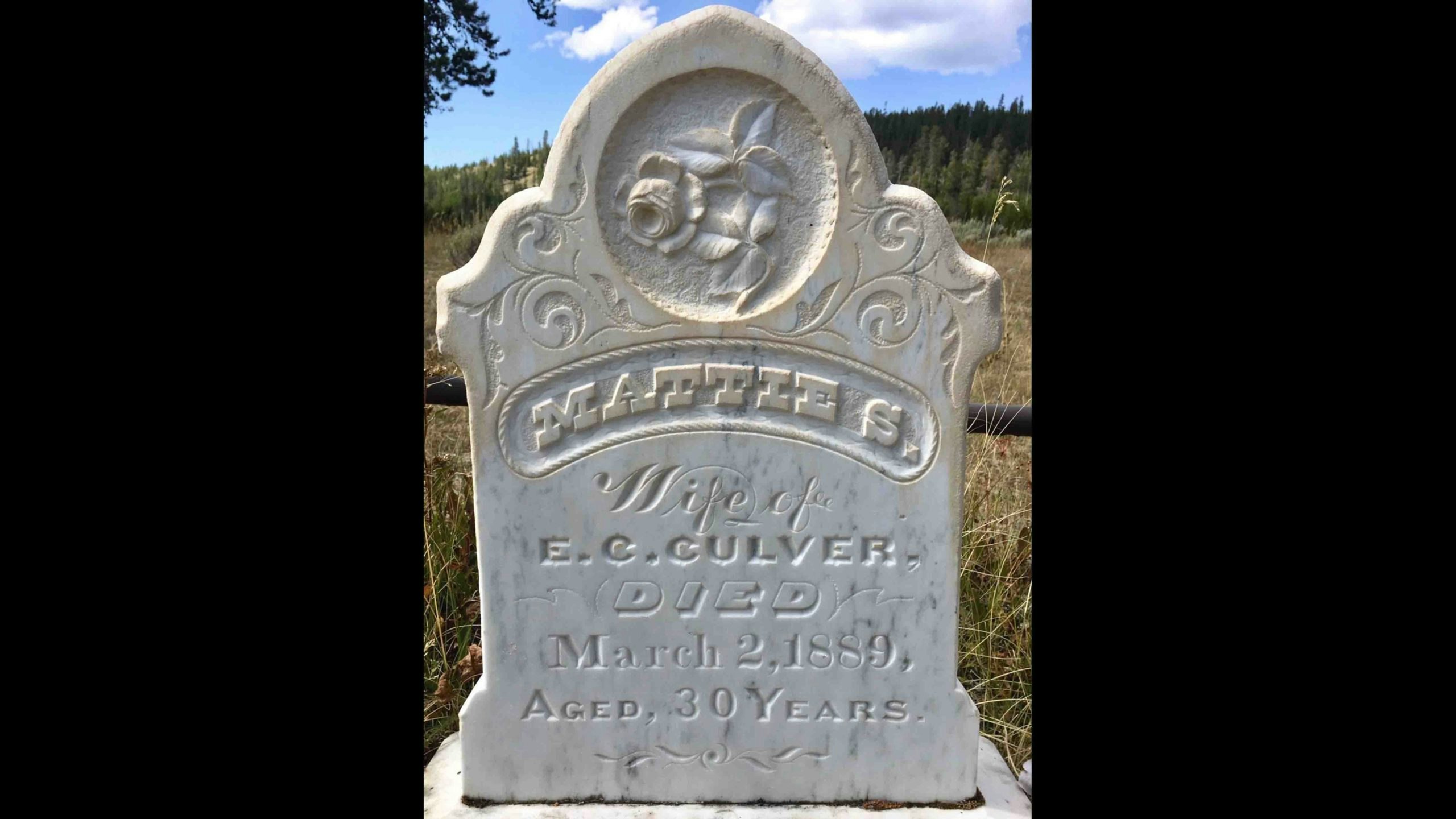By Jen Mignard
Tucked behind a small copse of trees, and a picnic area vault toilet, lies a solitary unmaintained grave marked by a weathered white marble headstone.
The grave is surrounded by a nondescript fence made of wood and metal pipe. On occasion one may even find sun faded plastic flowers at the base of the headstone intertwined with the grass and weeds that grow there. The inscription on the marker reads, “Mattie S.; wife of E.C. Culver; died March 2, 1889; aged 30 years.”
One hundred and thirty three years ago this spit of land at the confluence of the Firehole River to the west and Nez Perce Creek to the east was the location of the Firehole Hotel. It consisted of two roughly constructed primary buildings, one built in 1880 and the other in 1885, cottages, and several small out buildings.
The hotel itself was not opulent or especially comfortable according to historic accounts. The Yellowstone National Park Superintendent described the hotel’s construction as “rude” in 1886, and followed this in 1887 by reporting it was “needlessly ugly,” and “all the buildings at this place are of poor and mean construction.”
A particularly scathing review of the Firehole Hotel was printed in London, England’s 1887 Every Girl’s Annual, “A Lady’s Trip to the Yellowstone Park” by O.S.T. Drake:
“The hotel was primative [sic], being an unfinished log-hut, the daylight peering through every plank. My room was about six feet square sufficiently filled with two beds. It boasted neither drawers nor a table and a door that declined to shut. The walls were stretched over with canvas. It could not be described as luxurious and every snore was audible.”
New Family
Summer of 1887 found Mattie Culver joining the love of her life, husband Ellery, with their newborn baby, Theda, at the roughly made Firehole Hotel. Ellery was carrying out his duties as appointed “Master of Transportation” for the newly formed Yellowstone National Park. That fall the family returned to Billings, Montana where they had been living prior to Ellory’s appointment. They would overwinter in Billings until summer 1888, when they would again go back to the Firehole Hotel.
The second summer spent in the hotel saw Mattie’s health begin to decline. She was infected with tuberculosis, a deadly bacterial disease that wouldn’t have a cure for another 56 years. Theda was only a year old, and it was commonly believed that the nearby thermal features would improve Mattie’s illness. Ellery, desperate to prolong his wife’s life, made the decision to remain in the rough Firehole Hotel as the winter keeper.
Mattie’s health continued to deteriorate and her unfortunate fate was sealed. She passed away in the late winter of 1889 at age 30.
Frozen Pickle Barrels
The heavy Yellowstone snowpack and frozen ground made it impossible to immediately bury Mattie, so soldiers from a nearby outpost placed her body in two pickle barrels arranged end-to-end. The barrels were then covered in snow until an adequate hole for burial could be carved out of the frozen ground behind the Firehole Hotel a couple weeks later.
That winter would be the last time the family would be together. Theda, not even two years old, was sent to Spokane, WA to be raised by her aunt. She died of pneumonia in 1906 at the age of 19 and was buried in Spokane.
Ellery continued his service to the park and was appointed to US Court Commissioner for Wyoming in 1892, where he served in that position at the courthouse in Mammoth, WY. Ellery retired to an Old Soldiers Home in California where his final wish was to be buried next to his beloved Mattie along the Firehole River. He passed away in 1922 and the National Park Service denied his burial request. Instead, Ellery was interred at the National Soldiers Home Cemetery in Los Angeles, CA.
All That Remains
The Firehole Hotel was closed, razed, and burned in 1891 and never rebuilt. Mattie’s solitary grave is all that remains.
It is said that Mattie can be seen fretfully wandering alongside the Firehole River at dusk looking for her lost family when the veil between our world and the spiritual plane is the thinnest. She is supposed to be mourning the baby she was not able to raise, and she yearns for the husband whose earthly body wasn’t allowed to share eternity next to hers.
Visitors to Ellery’s California grave report that it does not feel like he is still there. That his spirit has left to find his wife.
And some say if you are quiet and listen carefully in the quiet of the evening at the Nez Perce picnic area, where Mattie’s grave is located, you may be able to hear her singing and calling for her family.





